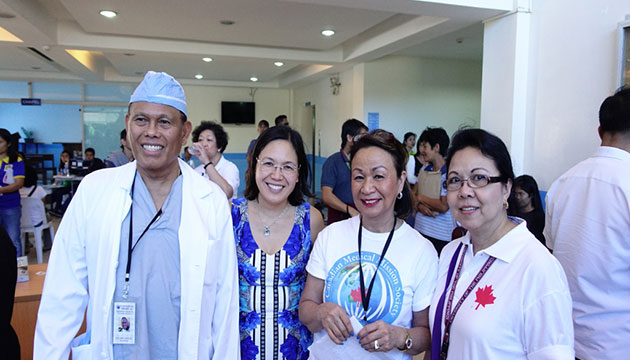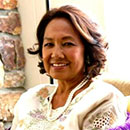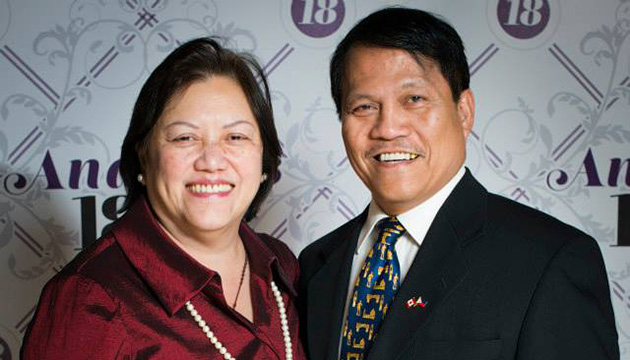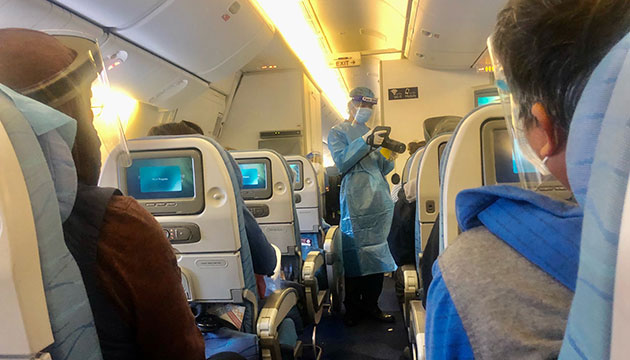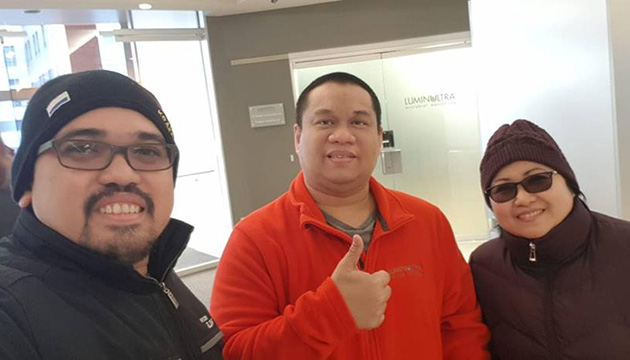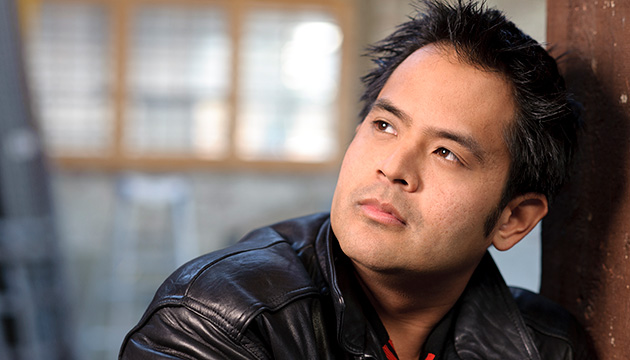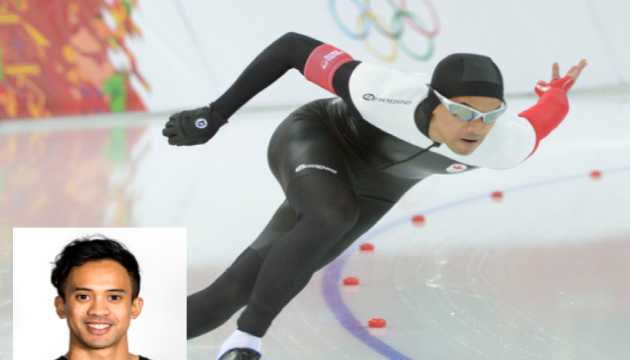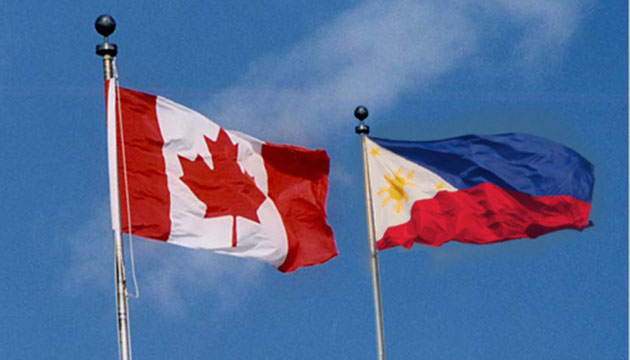For two weeks in February 2016, 1,500 indigent Filipinos in and around Lipa City in the Philippine province of Batangas received free medical treatment from 100 Canadian, American, and Filipino volunteer health professionals.
Evelyn Mayuga, co-founder of the Vancouver-based Canadian Medical Mission Society (CMMS) and corporate secretary and director of medical missions of the group established in 2010, coordinates the massive humanitarian work that provides free medical and surgical treatment to poor Filipinos annually in different parts of the Philippines.
A Canadian Filipina, Mayuga is an occupational therapy graduate of the University of the Philippines. She worked in her profession in B.C. from 1974 to 1995, including stints as an occupational therapist with the B.C. Centre for Ability, and the Workers Compensation Board Rehabilitation Clinic.
Her husband, Henry Mayuga, an architect and developer in Canada and the Philippines, is mainly responsible for identifying communities in the Philippines that need free health care services.
I met this extraordinary couple in Metro Manila as they were preparing for the Lipa City mission. Evelyn gave this interview upon completion of the mission.
Eleanor Guerrero-Campbell: How did the Canada Medical Mission to the Philippines come about? What triggered the idea? It's a lot of work - why did you decide to do it?
Evelyn Mayuga: Dr. Dan Vargas, ear, nose and throat specialist from Surrey, B.C., approached Henry and me, and broached the idea of forming a non-profit group to do surgical missions. He was involved in another mission group to the Philippines previously, which offered eye, ear and throat services. Dan proposed that the main focus of our service will be ear, nose and throat. With Henry having set up an architectural practice in the Philippines, this allowed him to be in contact with the right people. So both of us saw the opportunity of helping the underprivileged in our country with their urgent health care needs.
The Canadian Medical Mission Society (CMMS) was incorporated as a non-profit society in 2010. The founders are Toni and Dan Vargas, Edward Teodoro, Evelyn and Henry Mayuga. There were four more Filipinos who joined the Society initially but opted out because of other commitments.
Eleanor Guerrero-Campbell: How does the medical mission work? For example, what medical services are provided? Are these services free? Who are eligible to get treatment - are there any criteria? How do the patients know about the mission, and how are they selected? In what facilities are the medical services provided?
Evelyn Mayuga: Our mission planning starts with a fundraising drive. Then my work starts by communicating with provinces that have indicated their desire for a surgical mission to serve their poor constituents.
Since the thrust of our mission is surgical, we require the use of a government tertiary hospital as we need the necessary equipment and hospital services like operating rooms, hospital equipment, recovery room, laboratory, dental clinic, etc. to carry out the various services that CMMS offers. We provide services in major surgery, minor surgery, restorative and surgical dentistry, audiology (includes hearing tests and free hearing aid with six months supply of batteries), and family medicine. We bring all our medical, dental, and surgical supplies as well as drugs and medications that we need like anesthesia agents, antibiotics, analgesics and multivitamins. All these services and medications we dispense are for free. We also bring with us used clothing for children, toys, candies, cookies and donations like school supplies, reading glasses which we distribute in our out-patient consultation service.
One of my responsibilities is to make sure that the hospital is equipped to support our mission objectives. So If I cannot personally do an ocular inspection of the hospital, then Henry does it. Once the hospital is identified, we then communicate and or meet with the hospital director and the provincial and or city health officials, and discuss the mechanics of our mission. We provide the list of cases that our team can undertake then transmit this to the hospital in the Philippines. The representatives of the above offices will then pre-screen patients in various barangays through the assistance of the local Department of Social Welfare staff. Our requirement is to provide treatment only to indigent patients.
The barangay captains in various areas of the province or city are responsible for disseminating the information from the health officials to the citizens in their community. They also make use of the radio, churches and local organizations to spread the word about an upcoming mission.
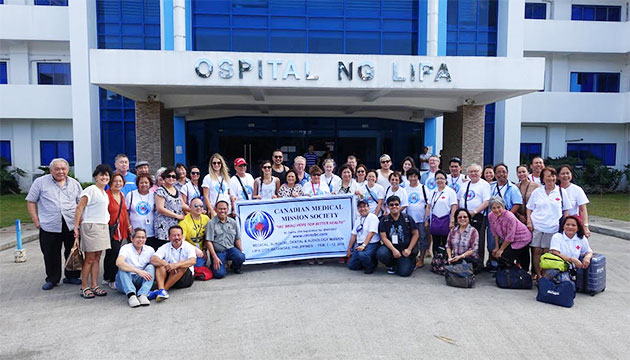
EGC: How is the medical mission financed? What is the Canadian contribution? The Philippine contribution?
EM: As stated, we do fundraising drives to finance our mission. All the funds we raise go towards the purchase of supplies and medications we need to bring with us to the mission. During the launch of the Society in 2011, the B.C.provincial minister of health pledged $25,000. We were able to do our first surgical mission because of the funds donated by the provincial government. In 2012, the CMMS was granted a charitable status and Revenue Canada issued the society a charity number. Therefore, we are now able to solicit from audiology and dental suppliers as well as medications from Health Partners International of Canada, Natrapharm and Europharma. Pharmaceutical companies in the Philippines have also donated medications and multivitamins. A couple of our society members know the owners of these companies, so they willingly support our mission work.
EGC: What typical medical services do you provide and who provides them? For example, what typical diseases are treated? How many Canadian medical professionals have participated on the mission? What are their professions? Are they mostly Filipino Canadians? Canadians of various ethnicities? Are they young practitioners, mature ones? What parts of Canada do they come from?
EM: We do this endeavour annually every February for two weeks. We have done surgical missions in Vigan, Tarlac (twice), General Santos City (twice) and Lipa City.
In our Lipa City Mission, we expanded our services from ear, eye, nose and throat only, to a broader range of services that includes obstetrics and gynecology, urology, plastic surgery, abdominal surgery, and family medicine services. Cases we did were: excision of benign masses, sebaceous cysts, Baker's cysts, adenomas, lipomas, fibromas, keloids, warts and laceration repairs for minor surgery cases; thyroidectomy, tympanoplasty, mastoidectomy, parotidectomy, tonsillectomy, myringotomy, excision of facial and oral tumours, cheiloplasty, uncomplicated hysterectomy, myomectomy, D&C, oopherectomy and excision of other pelvic cysts, vaginal procedures and repairs, tubal ligation, vasectomy, hernia, uncomplicated cholecystectomy, appendectomy, excision of testicular tumor, mastectomy, hemorroidectomy and other anorectal procedures for major surgery cases.
When we get cases that we are unable to do because we do not have the particular specialist in the team, or the hospital is not equipped to allow us to operate on the patient, we then use our resources to refer the patient for proper management and treatment. In a couple of cases, all our CMMS volunteers had contributed towards the transportation and living expenses of the patient that we have referred for treatment either at Philippine General Hospital or Jose Reyes Hospital. In our Lipa City mission, we referred two cases to another surgical mission team in Binan, Laguna that has a specialized team that operates on imperforate anus, and another patient endorsed to the Hydrocephalus Foundation of the Philippines for proper treatment and management.
Our Lipa City mission team surgeons and anesthesiologists are Filipinos from Canada (B.C., Ontario, and Nova Scotia), and the U.S. (Illinois, South Carolina, Maine, Ohio and Las Vegas) and anesthesiologists from Germany and the Philippines. Our nurses, audiologists and support staff are a mix of young and retired volunteers who come from various ethnic backgrounds, residing in Canada or the U.S. In Lipa City, there was a total of 100 volunteers, 25 of whom are volunteers-dentists from the Philippines. Our support staff is composed of non-medical professionals like accountants, engineers, teachers, and recent science degree graduates who wanted to experience mission work. They do jobs like disinfecting surgical instruments, maintaining inventory of supplies, clinic clerks, recording statistics, photography and video recording.
Eleanor Guerrero-Campbell: How many missions have you done to the Philippines so far? In what areas? How many Filipinos have been treated by the medical missions?
Evelyn Mayuga: As mentioned earlier, we have now done six missions in the Philippines over the years. We treat over 1,100 annually in the two-week mission we undertake.This year (2016), the total number of treatments increased to 1,533 because we expanded our services. We have treated and referred patients for proper intervention since 2011 totaling almost 5,000 patients.
Whenever we go to a mission, we also look at what our group can further do to help the underprivileged community in terms of their healthcare needs. So we endeavour to help equip a government hospital and search for hospital equipment and supplies in Canada and we donate these to them. We donated a mammography machine, anesthesia machines, incubators and other hospital supplies to Tarlac Provincial Hospital in 2012. Then in 2014, we shipped a 40-foot container to Mindanao loaded with hospital beds and mattresses, anesthesia machine, four dental chairs, dental x-ray machine, treatment tables, chairs for use in hospital waiting areas and various surgical and hospital medical supplies. This endeavour was prompted when we visited the government city hospital which critically lacked the equipment and beds that were urgently needed. We saw three newly-born babies sharing a spring bed as the hospital did not have any bassinets in their nursery. The mothers did not even have a bed to sleep on, so they sleep on the floor. Whatever cribs they had in the neonatal intensive care unit were so old and rusty.
EGC: What do you think motivates Canadians to participate in your missions? Can you share some testimonials from Canadians who helped in the mission?
EM: The motivation of everyone in our group is to help deliver the urgent medical, dental and surgical needs of the poor. The retired former Filipinos who worked in the medical field are passionate about their desire to give back. The other non-Filipinos who hear about what we do, get inspired with the stories that our mission volunteers bring back with them. Our team has grown by leaps and bounds, and young volunteers have come forward, giving up their two-week vacation to join our mission, because of these anecdotes. We also get inquiries posted in our website asking how they can participate in our missions. I'm happy to ask some volunteers to contact you to provide testimonials.
EGC: How do you think medical missions help Filipinos? What are the main benefits? Why do we need Canadian medical missions at all? Aren't there enough Filipino doctors and nurses and dentists?
EM: It is obvious that the poor are the recipients of our humanitarian endeavour. A thyroidectomy will cost a farmer 200,000 pesos. An indigent patient cannot have the procedure done for free. So they wait until a surgical mission group will show up in their community. At this stage, the thyroid mass has gotten so huge that a partial thyroidectomy is no longer possible. So the surgeon has to do a full thyroidectomy, which requires a maintenance thyroid hormone medication for life. Whereas, if the mass is taken out at an early stage, maintenance medication is normally not necessary. For a farmer who has a family, he needs every hard-earned money to put food on the table or for the school needs of his children. A child from a remote area in the province who is born with a hearing deficiency will have a very slim chance at getting proper education. Therefore, this child will grow up being another farmer with a meagre income, unable to take care of his future family. Our audiology team does hearing tests and dispenses 80-100 hearing aids in a mission. The price for a set of hearing aids is from 175,000 pesos. The hearing aids that we dispense are donated by manufacturers and suppliers in Canada and cost a minimum of $1,800. So we bring with us a conservative estimate of $180,000 to $200,000 worth of hearing aids, and translated to Philippine peso, this is around 6.8 million. In addition, we give a six-month supply of batteries.
We had a special case in Lipa where a patient opted for alternative treatment of her breast cancer for three years prior to our mission because she could not afford the 800,000 pesos that she needed for her operation. Her condition had advanced to stage 4 and had resigned her life to God. Our surgeons did a modified radical mastectomy with the main goal of giving her a better quality of life. She has now been referred to an oncologist at Metro Manila's St. Luke's Hospital, who is a friend of one of our team surgeons, for further treatment.
EGC: How can Canadians help? How can they join up with your medical missions? What are your criteria? What medical professionals do you need? How long is a mission? What should 'medical missionaries' be prepared for when they treat Filipino patients?
EM: Anyone can access our website: www.cmmsbc.com and post their inquiry and we respond quickly. If their skills fit our needs then we welcome them to the group after they send us their CV. There is a $10 annual membership fee, payable to the Canadian Medical Mission Society.
The annual mission is always on the first two weeks of February. Our requirements are surgeons, anesthesiologists, operating room nurses, post-anesthetic recovery and medical nurses. All our volunteers pay for their transportation and hotel costs.
What foreign volunteers have to expect when they participate in surgical missions in third world countries, is the inadequacy of equipment available in public hospitals. They have to be prepared to make do with what is available and be flexible and innovative without sacrificing the quality of care that the patient requires.
We appeal to all citizens in B.C. to support our annual golf charity event. This is where we get the funds to finance our missions. For as long as the queue of patients seeking treatment that they cannot otherwise afford remain long, and we continue to have dedicated volunteers with big hearts for the underprivileged, our Society will endeavor to continue with our humanitarian work. Anyone can make a donation year-round, in kind and in cash, and tax deductible receipt will be issued upon request.


